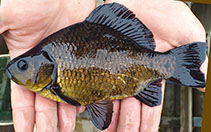Common names from other countries
分類 / Names 俗名 | 同種異名 | Catalog of Fishes(屬, 種) | ITIS | CoL | WoRMS | Cloffa
Teleostei > Cypriniformes (Carps) 鯉形目 (Carps) > Cyprinidae (Minnows or carps) 鯉科 (Minnows or carps) > Cyprininae
Etymology: Carassius: Latinization of , karass, karausche, European crucian carp (Ref. 45335).
More on author: Linnaeus.
Etymology: Carassius: Latinization of , karass, karausche, European crucian carp (Ref. 45335).
More on author: Linnaeus.
Environment: milieu / climate zone / depth range / distribution range 生態學
; 淡水; 半鹹淡水 居於水底的; 河川洄游 (Ref. 51243); 深度上下限 5 - ? m (Ref. 2163). 溫帶; 2°C - 22°C (Ref. 1672); 69°N - 35°N, 10°W - 169°E
分布 國家 | FAO區域 | 生態系 | 發現紀錄 | Point map | 簡介 | Faunafri
Eurasia: North, Baltic, White, Barents, Black and Caspian Sea basins; Aegean Sea basin only in Maritza drainage; eastward to Kolyma drainage (Siberia); westward to Rhine and eastern drainages of England. Absent from North Sea basin in Sweden and Norway. In Baltic basin north to about 66°N. Widely introduced to Italy, England and France but possibly often confused with Carassius gibelio (Ref. 59043). At least one country reports adverse ecological impact after introduction.
歐亞大陸: 西班牙橫越歐洲與中北亞到中國北方。 歐洲的魚動物相的一個建立良好要素。 至少一個國家報告引入後的不利的生態衝擊。
歐亞大陸: 西班牙橫越歐洲與中北亞到中國北方。 歐洲的魚動物相的一個建立良好要素。 至少一個國家報告引入後的不利的生態衝擊。
大小 / 重量 / 年齡
Maturity: Lm ? range ? - ? cm
Max length : 64.0 cm TL 雄魚/尚未辨別雌雄; (Ref. 6114); common length : 15.0 cm TL 雄魚/尚未辨別雌雄; (Ref. 556); 最大體重: 3.0 kg (Ref. 556); 最大年齡: 10 年 (Ref. 59043)
Max length : 64.0 cm TL 雄魚/尚未辨別雌雄; (Ref. 6114); common length : 15.0 cm TL 雄魚/尚未辨別雌雄; (Ref. 556); 最大體重: 3.0 kg (Ref. 556); 最大年齡: 10 年 (Ref. 59043)
簡短描述 檢索表 | 型態特徵 | 形態測量圖
背棘 (總數) : 3 - 4; 背的軟條 (總數) : 13 - 22; 臀棘: 2 - 3; 臀鰭軟條: 5 - 7; 脊椎骨: 32. Diagnosed from its congeners in Europe by having the following characters: body golden-green shining color; last simple anal and dorsal rays weakly serrated; 23-33 gill rakers; lateral line with 31-36 scales; free edge of dorsal convex; anal fin usually with 6½ branched rays; and peritoneum white (Ref. 59043). Caudal fin with 18-20 rays (Ref. 2196). No barbels. The third dorsal and anal-fin rays are strong and serrated posteriorly.
尾鰭有 18-20個鰭條。 (參考文獻 2196) 沒有觸鬚。 第三個背鰭與臀鰭-鰭條在後部地是強的與鋸齒狀的。
尾鰭有 18-20個鰭條。 (參考文獻 2196) 沒有觸鬚。 第三個背鰭與臀鰭-鰭條在後部地是強的與鋸齒狀的。
Adults occur in shallow ponds, lakes rich in vegetation and slow moving rivers. They burrow in mud in the dry season or during winter (Ref. 2163). Usually restricted to densely vegetated backwaters and oxbows of lowland rivers. Can survive at high temperatures and at very low oxygen concentrations during summer and under ice cover (Ref. 59043). Tolerates cold, organic pollutants, and low oxygen levels in the water (Ref. 30578). Feeds all day but mainly at night on plankton, benthic invertebrates, plant materials and detritus. Usually does not occur in waters with rich ichthyofauna and abundant predatory species, but very abundant in the absence of other fish species. Spawns in dense submerged vegetation (Ref. 59043). Marketed fresh and frozen; eaten fried, broiled and baked (Ref. 9988). Live up to about 10 years. There is a gradual but continuing extirpation in many water bodies, especially in Danube drainage and central Europe, possibly to due competition with introduced Carassius gibelio in non-optimal habitats (Ref. 59043).
出現於水淺的池塘,湖豐富的在植物與緩慢移動的河。 穴居在泥中乾季時或在冬天期間.(參考文獻 2163) 在水容忍寒冷,有機的污染物質與低溶氧量。 吃植物, 昆蟲幼生與浮游生物.(參考文獻 30578) 在市場上銷售生鮮和冷凍; 油炸後食用, 火烤.而且燒烤.。 (參考文獻 9988) 時常與 C. gibelio 互相混淆。 (參考文獻 59043)
出現於水淺的池塘,湖豐富的在植物與緩慢移動的河。 穴居在泥中乾季時或在冬天期間.(參考文獻 2163) 在水容忍寒冷,有機的污染物質與低溶氧量。 吃植物, 昆蟲幼生與浮游生物.(參考文獻 30578) 在市場上銷售生鮮和冷凍; 油炸後食用, 火烤.而且燒烤.。 (參考文獻 9988) 時常與 C. gibelio 互相混淆。 (參考文獻 59043)
Life cycle and mating behavior 成熟度 | 繁殖 | 產卵場 | 卵 | 孕卵數 | 仔魚
Females spawn multiple times during the spawning period (Ref. 88808). Reproduction in May-June in shallow water with dense vegetation, eggs 130000-250000/female adhere to plants, hatch after 4-8 days (Ref. 2163). Individual female spawn with several males. Males follow ripe females, often with much splashing. Eggs are sticky and are attached to water plants (Ref. 59043).歐亞大陸: 西班牙橫越歐洲與中北亞到中國北方。 歐洲的魚動物相的一個建立良好要素。 至少一個國家報告引入後的不利的生態衝擊。
主要參考資料
Upload your references | 參考文獻 | 合作者 | 合作者
Kottelat, M. and J. Freyhof, 2007. Handbook of European freshwater fishes. Publications Kottelat, Cornol and Freyhof, Berlin. 646 pp. (Ref. 59043)
人類使用
漁業: 高經濟性; 養殖: 商業性; 游釣魚種: 是的; 水族館: 商業性; 誘餌: occasionally
更多資訊
Population dynamics
成長參數
Max. ages / sizes
Length-weight rel.
Length-length rel.
長度-頻率
Mass conversion
入添量
豐度
成長參數
Max. ages / sizes
Length-weight rel.
Length-length rel.
長度-頻率
Mass conversion
入添量
豐度
Physiology
Body composition
Nutrients
耗氧量
游泳類型
游泳速度
Visual pigments
Fish sound
Diseases & Parasites
Toxicity (LC50s)
Body composition
Nutrients
耗氧量
游泳類型
游泳速度
Visual pigments
Fish sound
Diseases & Parasites
Toxicity (LC50s)
工具
E-book | 野外調查 | 檢索表 | 長度- 頻率 Wizard | 生活- 歷史的工具 | 分布圖 | Classification Tree
| Catch-MSY |
特別的報告
下載 XML
網路資源
Alien/Invasive Species database | Aquatic Commons | BHL | Cloffa | BOLDSystems | Websites from users | 檢查 FishWatcher | CISTI | Catalog of Fishes(屬, 種) | DiscoverLife | ECOTOX | Faunafri | Fishtrace | GenBank(基因組, 核甘) | GloBI | GOBASE | | Google Books | Google Scholar | Google | IGFA World Record | MitoFish | 國家資料庫 | Otolith Atlas of Taiwan Fishes | 公眾的水族館 | PubMed | Reef Life Survey | Scirus | SeaLifeBase | 樹狀分類階層 | Wikipedia(去, 搜尋) | World Records Freshwater Fishing | 動物學的記錄
Estimates based on models
Phylogenetic diversity index (Ref. 82804): PD50 = 0.5156 [Uniqueness, from 0.5 = low to 2.0 = high].
Bayesian length-weight: a=0.01349 (0.01051 - 0.01732), b=3.04 (3.00 - 3.08), in cm Total Length, based on LWR estimates for this species (Ref. 93245).
營養階層 (Ref. 69278): 3.1 ±0.24 se; based on food items.
回復力 (Ref. 120179): 中等的, 族群倍增時間最少 1.4 - 4.4年 (tm=2).
Fishing Vulnerability (Ref. 59153): Moderate vulnerability (39 of 100).





